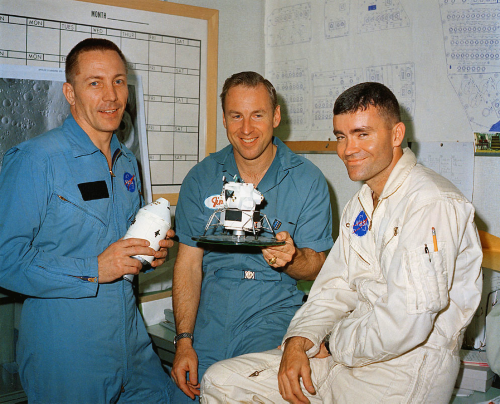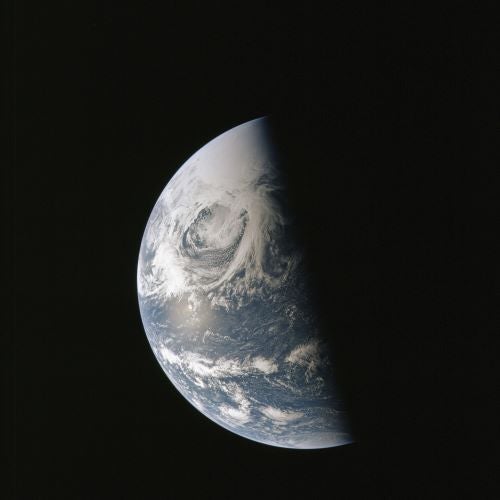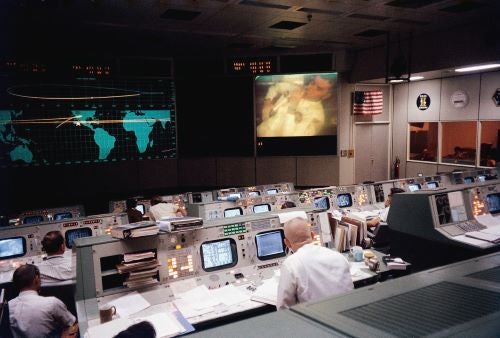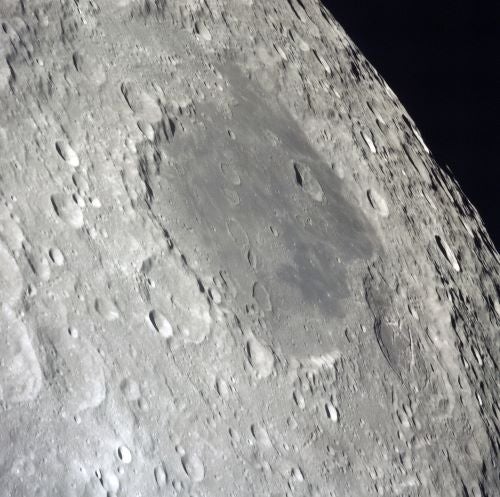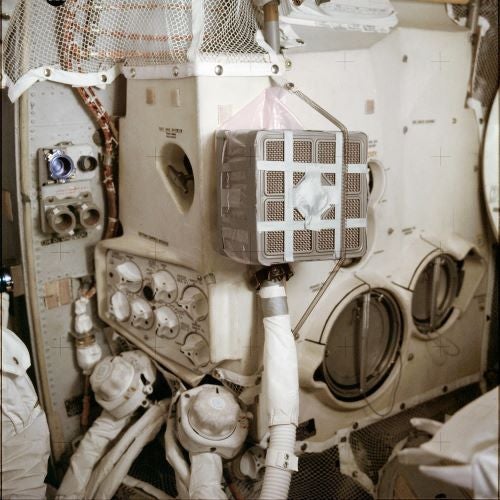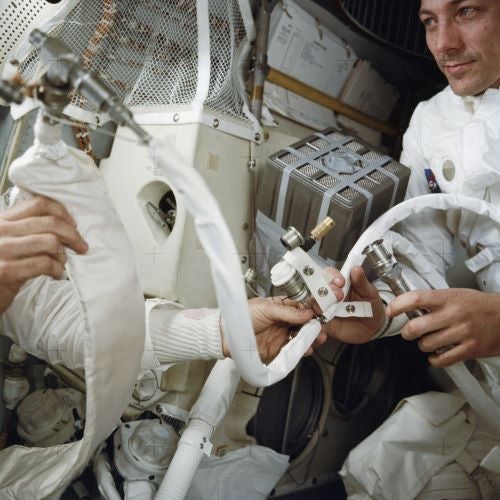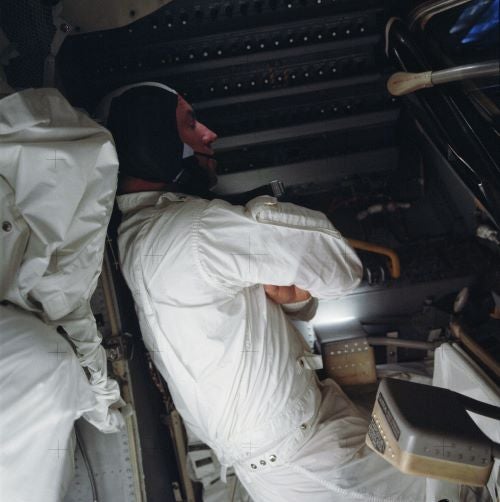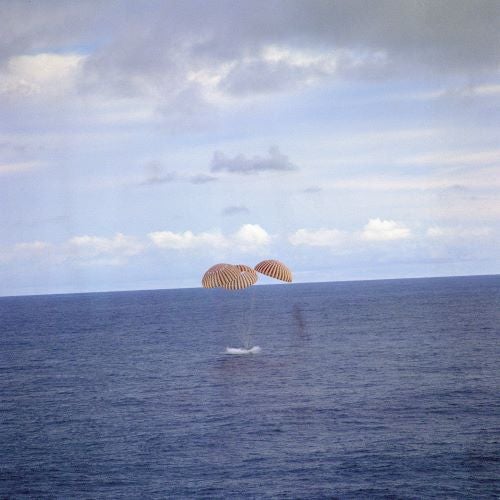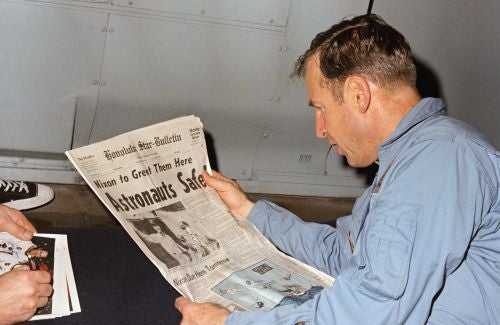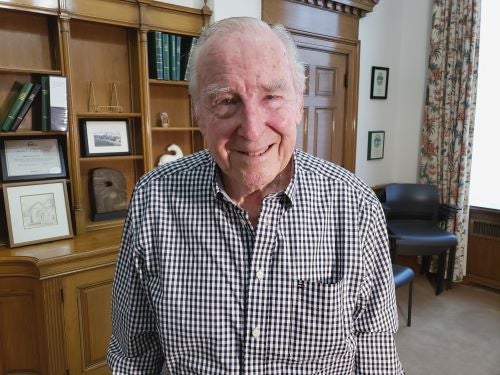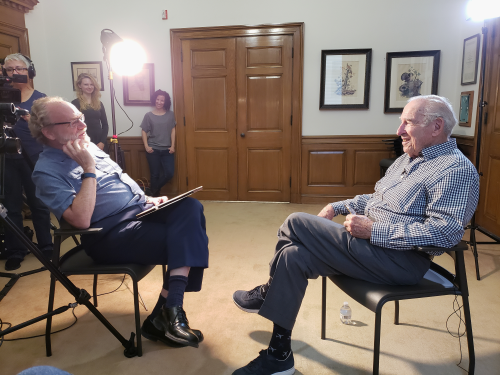Jim Lovell served as Apollo 13’s commander. This was his fourth trip into space. He had previously teamed with Frank Borman on Gemini VII in December 1965, when they achieved the first rendezvous with another manned spacecraft; with Buzz Aldrin on Gemini XII in November 1966, that program’s final mission; and with Borman and Bill Anders on the historic Apollo 8 mission in December 1968 that first sent astronauts to the Moon. On Apollo 13, he was joined by a pair of rookies: Command Module Pilot Jack Swigert and Lunar Module Pilot Fred Haise. Swigert was a last-minute replacement for Ken Mattingly, who had been exposed to German measles a week before launch and was the only crew member who did not have immunity.
The first two days of the mission went largely according to plan, if little noticed by the broader public. None of the three major U.S. TV networks carried the crew’s primetime television broadcast the evening of April 13. But the world certainly took notice later that night when an oxygen tank in the service module exploded and put the mission — and the lives of the astronauts — in jeopardy. The harrowing return journey transfixed the nation and the world.
Recently, I had the honor to interview Captain Lovell about Apollo 13 at the Lake Forest, Illinois, public library. As you might expect, the events of the mission remain etched in his mind even after 50 years.
[The following has been edited for clarity and length.]
Astronomy: Thank you, Captain Lovell, for joining us today and reminiscing about Apollo 13, whose 50th anniversary is coming up quickly. We have several questions about the mission and your reactions to everything that transpired during Apollo 13. My first question is, Apollo 13 was going to be the third Moon landing. Could you talk a little bit about the objectives of your mission and how it differed from Apollo 11?
Lovell: Well, actually, this is the first time that we were really going for exploration or discovery. The first [two], Apollo 11 and Apollo 12, were merely machines to say, “Hey, we can do the job. Here it is.” … But by the time 13 came around, [NASA] didn’t worry so much about the transition and the mechanics of getting to the Moon. What the scientists were now looking at was the Moon itself. We were going to a place called Fra Mauro. Fra Mauro was supposed to be a very informative place with different kinds of materials than 11 or 12 picked up. That was our whole objective, and so that’s what we trained for. Unfortunately, we didn’t make it.
Astronomy: I understand your crew was originally scheduled to fly on Apollo 14 and not 13, but NASA rejected [Director of Flight Crew Operations] Deke Slayton’s recommendation for the Apollo 13 crew, and thus bumped you up. I was wondering, how did you feel about that at the time and how do you feel looking back on that in retrospect now?
Lovell: Well, it’s kind of interesting. After Apollo 8, … I was the backup to Neil on Apollo 11. Then I was assigned Apollo 14, so we started training for that, but the NASA management determined that Al Shepard didn’t have enough training. He was grounded for some time.
So one day Deke came in and said, “Look, we want to put you on 13 rather than 14.” I thought that would be fine. I mean, we’d be coming up six months or some time earlier. It’d be an earlier flight.
I went home and I told my wife, “We’re gonna go on 13, not 14,” and she said, “13?” I said, “Well, it comes after 12.” [Laughs.] Then they put that in the movie. [Laughs.]
Astronomy: How do you feel about that, looking back now?
Lovell: Well, being in the government at NASA, we don’t believe in myths like the number 13, but it did have — as you look at the flight and you analyze the mission from its inception to the finality of it, you’ll see that it was plagued by bad omens and bad luck from the very beginning. One by one, now that I look back on it, I can see the things that occurred that told me that, hey, something’s gonna happen here.
Astronomy: Can you mention a few of those things?
But years before the flight, this tank had been dropped in the factory. Now they tested it out for everything it had to do to supply oxygen to the spacecraft, but they failed to look at the mechanisms and the tubing to remove the oxygen after a routine test. So when the flight crew, after the last test, just two weeks before the flight, tried to remove the oxygen, they couldn’t do it.
So they looked at the schematics of the tank. They looked and they said, “Well, wait a second. This tank has a heater on it. And we should just apply ground power because we have ground power at the launch site” — 65-volt ground power, while the spacecraft flew at 28-volt power.
They applied the 65-volt power to the oxygen tank’s heater system and, as they predicted, it worked out. They boiled the oxygen out of the tank and made everything all squared away, all set to go. But what they didn’t know, as the temperature in the tank got up close to 80 degrees, which is kind of unusual for liquid oxygen, the little thermostat was gonna open up to shut off the power and keep the heat down. But when it came up, the higher voltage welded those contacts shut, and from then on, we had no safety.
As it turned out, the temperature got up to 300 or 400 degrees. The ground crew never knew it. The oxygen was all removed. The tank didn’t explode for some strange reason. All the oxygen got out. But the day before the flight, they put liquid oxygen back into it, and from then on it was a bomb waiting to go off.
But the anomaly of this whole thing was, back in 1965 I think it was, the manufacturer of the spacecraft told the manufacturer of the liquid oxygen tank to change the circuit breakers or the thermostats from being compatible for 28-volt to 65-volt. They did not do it. They did not do it.
Then, what made things worse is that the manufacturer didn’t double-check his directive to do it and, consequently, they damaged the tank, and then 200,000 miles out — on April 13 — the tank exploded.
Of course, other omens were we had [exposure to German] measles just before the takeoff and Jack Swigert had replaced Ken Mattingly. So these are the things that led up to Apollo 13 [being] unusual.
Lovell: Yes, we did. Suddenly, the center engine shut down I think one minute or two minutes early, and we had that big light blinking at us and we said, “Boy, what’s the story?”Well, it turned out that on the third stage we had enough fuel to get into Earth orbit and then go around, and with enough fuel left on the third stage to give us the velocity to go to the Moon. But that was another little bad omen.
The funny thing is on one of the unmanned Saturn Vs — there were two unmanned Saturn V launches — that same thing had occurred, and they felt they had everything all squared away by [the time of our launch]. Of course, on 8 and 10 and 11, everything worked fine.
Astronomy: Can you describe your reaction when you heard the loud bang that resulted from the oxygen tank exploding?
Lovell: Well, first of all, we didn’t know. I heard a loud bang. The funny thing is during our test phases, while we were in the spacecraft, Fred Haise made things kind of funny. He would pull on a — I think it was an oxygen valve or something — it sort of gave a bang, too.
And I thought at first that it was Fred. “Why is he doing that again?” Then I looked up at him. I had been down in the command module. I looked up at him and his eyes were as wide as saucers. I could tell. He said, “It’s not me.” Then, of course, things started to happen.
Astronomy: When you saw the gas venting from the command module, how quickly did you realize that this was something major?
Astronomy: How did you hold your composure in such an extraordinary and unprecedented moment of crisis?
Lovell: Well, when you’re in a situation like this, I could have bounced off the walls for 10 minutes trying to figure out what to do, and then nothing would have changed. And remember, the crew was former test pilots. So I had been used to an engine quitting occasionally when testing airplanes and things like that.
So I finally had to decide what to do. We knew quite quickly that we were in a dying vehicle and that we were gonna have to go into the lunar module, because it was the only thing that still had oxygen tanks. Because of the loss of electrical power, we lose our rocket engine on the command module. So it was gonna be dead, which is exactly what happened.
We discussed it. Finally, I forget exactly when, we got to talk to the ground. The ground at first thought that this was a communications problem, that somehow we were interrupted by the radio waves or the rays coming from the Sun or something of this nature, and giving all these false indications on the consoles down there. But we knew what the story was right from the beginning.
So they finally agreed that that was the case, let’s go in the lunar module. The first thing we did, which was very, very fortunate, we took the guidance parameters out of the guidance system and put them into the guidance system in the lunar module. So the guidance system in the command module knew our attitude with respect to the celestial sphere. So we got that information back into the lunar module’s guidance system — which was dead, we had to fire it up — and put it in. So we knew then in the lunar module what our attitude was, so we could use the lunar module later on with [its] engine to maneuver to different attitudes.
Lovell: It took a little while, but that was the first thing they thought of. It’s kind of interesting. We started out to the Moon on a free-return course, which essentially meant that if our engine quit in the service module, that we were on a course that would take us all the way to the Moon and … with the help of the Moon’s gravity, we’d switch around and come back on a course to the Earth at such an attitude that we could cut into the Earth’s atmosphere.But then about, I don’t know, 20 hours after we were taking off, going from the Earth to the Moon, they called up and said, “Look, we’ve looked at your situation. When you get around to starting to go down to land on Fra Mauro, we’ve kind of figured out that the Sun is gonna be just above you. So it’s gonna wipe out everything down below. You’re gonna be like landing in a saucer of milk. So we’re gonna get you off that free-return and put you on a course that when you get around and start landing, you’ll start to see the craters and the shadows and things like that.” So that’s fine.
Then, of course, when the accident occurred, we were in a position that, had we not gotten off that course, [we would have gone] around the Moon [and come] back to the Earth, [but] we would miss the Earth completely and we’d end up in a long elliptical orbit, going back out to where the Moon was, back to where the Earth was, back to the Moon; I don’t know, for years, I guess.
[But] that’s fine with me because I know we’re not gonna slow down, either. So I’ve got the velocity to not get captured by the Moon, to get back home again.
Astronomy: That’s good. The lunar module obviously was never designed to operate as a lifeboat and using it was truly unprecedented. How difficult was it to operate and maneuver the lunar module, running the engines and using that to navigate back home?
Lovell: Well, normally a lunar module is like any other vehicle.
I mean, when you do things, when you do the controls, they’ll go the way they were designed to go and you learned it that way. But when the explosion occurred and we had to use the lunar module, [we still] needed the command module and its heat shield to get back into the atmosphere.
[This is] what happened when I first tried to maneuver the vehicle, before we got to the Moon, to get back on that free-return course [after] the ground gave us the particular attitudes to do it. [When] I started to maneuver in the normal way — it didn’t work.
The center of gravity, instead of being in the center of the lunar module like it is normally, was way out in left field someplace, and if I wanted to go right, it went someplace else. If I wanted to go left, it [went someplace else].
So I literally had to learn by the [way it handled] how to maneuver, or how to place my controller to get to the proper position. It took a little while for me to do that. But, fortunately, when you’re in deep trouble, you learn pretty fast.
Astronomy: Is it true that Jack and Fred were captivated with taking photos of the lunar farside?
Lovell: [Laughs.] Well, after we got back on the free-return course, the ground came up again and said, “Look it, we have analyzed your situation and the amount of electrical power you have on the lunar module, and it’s fairly touch and go. We think you’ll run out before you get back, and you’re gonna have to have electrical power to get your final position for landing. And so we’re gonna speed you up.”
This was on the way to the Moon. So we have a crew down in the simulators now working out the directions. Then, as we got closer and closer to the Moon, they said, “By the way, when you get behind the Moon now, you’ll lose communication with us, so be sure you’re ready to copy [our instructions].” And I said, “Well, I have my two companions, and if I miss something to copy on this next procedure, I’m sure they’ll pick it up.”
So as we got very close to the Moon, they call up and say, “Are you ready to copy?” and I said, “I am,” and I started to copy. And I looked at my companions. They weren’t paying any attention. They had cameras in their hands. Can you imagine, with cameras in their hands?\
I said, “Gentlemen, what are your plans here?” They said, “As we go around the farside of the Moon, we’re gonna take some pictures.” And I said, “If we don’t get home, you won’t get them developed.” [Laughs.] But I got the procedures, they got their photographs, and so we came home.
Astronomy: How ill did Fred get on the trip back home? Was that a major concern for you?
Astronomy: What were your thoughts as you splashed down in the Pacific and you knew that you had made it home safely?
Lovell: Of course, it was one of pure delight. We were coming back in, and we got through that one other big problem that we had, that we were being poisoned by our own exhalations. The environmental system in the lunar module had just one canister to remove carbon dioxide, and it was designed only for two guys for two days, and we were three guys for four days.
So we had to figure out a way of getting rid of the carbon dioxide, which Mission Control did. They figured out a way of taking a canister from the dead command module, which was square, and trying to fit it into a round hole, which we finally did with duct tape and everything of that nature. And it worked. This was a miraculous thing, because if that didn’t happen, that carbon dioxide was building up and I don’t know what would have happened then.
So we decided, well, maybe that’s a good idea. I talked to Jack Swigert at that time and Fred Haise, and then nothing happened for a while. Days went by, or years went by, actually.
Then a fellow by the name of Jeff Kluger called up and he was a writer for Discover magazine. He said, “I’ve always wanted to write a story on NASA and the space program, and I thought 13 was the way to go.” I said, “That’s what we’ve been thinking about.”
But by that time, Fred had a job with Grumman and so he wasn’t interested, and Jack had died. … And I said, “Well, let’s do it. We’ll split. We’ll go fifty-fifty. I’ll be the guy that gives some of the information.” I liked his writing, and so that’s what we did.
That’s what started out to be Lost Moon. … It’s kind of funny how [the movie] got started. … We hadn’t finished the book yet, when our [agent] said, “Look, there’s some interest in the movies for it.” So I got a call from Ron Howard: “Could you come out and talk to me about this particular story?”
It turned out that the son of a flight controller also worked for Ron Howard, and his job was to go through all the books and the scripts and everything that people handed him, to see if they’re worthwhile making a movie. He saw this manuscript, which was not completed, and he went to Ron Howard and he said, “Look at this. I think this would be kind of interesting.” So [Jeff] and I went up and talked to him, and that’s how it all got started.
Astronomy: From the Apollo 13 film as well as from your getting safely back home, I think in most people’s minds, Apollo 13 is right up there with, or maybe just a little bit below, Apollo 11 in terms of what people remember about the Apollo program. How does it feel to be part of something that didn’t work, but, in the end, ended up becoming even more famous?
About 18 years … after that, I had a classmate that went out there and he saw it and he wrote me a letter. He said, “Do you know where your spacecraft is?” I didn’t at that time. No one told me it was in Le Bourget.
Then, later on, a year or so later, my wife [Marilyn] and I were in Paris and we went out to this museum, which was at the airfield there, and there we saw it. We walked up to it. It was still on the cradle that they had rolled it in on. It was all by itself, just about, nothing else around it. The hatch was missing. The instrument panel was missing. The seats were missing. The only thing I saw was … a piece of paper that was stuck on the side that said, “Apollo 13,” and gave the names of the three crew members. … And then Ron Howard made the movie. Of course they made the movie that was shown in France, and all those French people said, “Oh, it’s out there in Le Bourget. Let’s go see it.”
Meanwhile, NASA was so embarrassed and the Smithsonian, that a museum out of Hutchinson, Kansas, called the Cosmosphere, offered to go get [it] and bring it back and pay for it — and they did. And all those Frenchmen now were mad because they had kept it for 20 years, and now it came back here. [Laughs.]
Astronomy: Do you recall what the first thing you and Marilyn talked about once you returned after Apollo 13? What did that conversation go like? Did [she] encourage you to find a different career path maybe?
Lovell: Well, I have to tell you another interesting story along those lines. About a week or two weeks after we got picked up in Hawaii and then we came back, we had a big press conference of course. All the NASA people came in and all the reporters came in, and TV people and stuff like that, and a lot of the families came in to listen to the whole thing. We were in the auditorium down in the Johnson Space Center. So we started talking about that.
At the beginning of the conference, a reporter asked, “Jim, are you gonna ask for another flight? Obviously, this was not successful.” Before that, on Apollo 11 [and] 12, management said, “Look, if there’s a problem with this flight, we’ll get you back and we’ll give you the very next one.”
So when that question came up from the reporter, I thought to myself, because management was right behind us, here was the perfect opportunity to put them on the wall and say yes, because they had not talked to us, the 13, just 11 and 12. I was about ready to say something like that when, out in the audience, I saw a hand go up. Then I saw it go down like this. [Jim gives a thumbs down gesture.] It was my wife. [Laughs.] I could tell. I said, “No. I think this is the last flight I’m gonna make.” [Laughs.]

